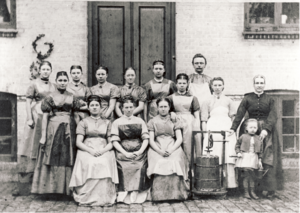Hanne Nielsen facts for kids
Quick facts for kids
Hanne Nielsen
|
|
|---|---|
 |
|
| Born | 11 September 1829 |
| Died | 15 June 1903 (aged 73) |
| Nationality | Danish |
| Occupation | Butter and cheese maker |
Hanne Nielsen (born September 11, 1829 – died June 15, 1903) was a clever Danish farmer. She might have invented the famous Havarti cheese. In the 1800s, Hanne traveled all over Europe. She wanted to learn the best ways to make cheese. Her farm was called Havarthigaard, and it was near Copenhagen, Denmark.
After her travels, she created a new way to make cheese. Hanne was also a teacher, a writer, and she managed the money from her farm. Her delicious butter and cheese were even served to royal families. One special cheese she made with cumin was enjoyed by King Christian IX of Denmark.
Contents
Hanne's Early Life and Farm
Hanne Nielsen was born on a farm in Søllerød, near Copenhagen, on September 11, 1829. When she was 19, she married Hans Nielsen. They lived together at a farm called Havarthigaard.
Hanne and her husband first sold milk from their cows. But Hanne thought they could earn more money. So, she decided to sell the milk as butter and cheese instead. Her butter and cheese sold well right away.
Learning New Cheesemaking Skills
Even though her products were popular, Hanne wanted to make them even better. She decided to learn more about dairy farming. She traveled to many countries, like Norway, Sweden, Switzerland, and France. She wanted to find out how to get the best results.
Hanne learned how to make different kinds of cheese. She learned cheddar cheese in England and brie and Roquefort in France. In the Netherlands, she learned to make Gouda and Edam cheese.
Hanne's Amazing Career
Hanne Nielsen opened a special dairy school on her farm. From 1866 to 1903, she taught about 1,000 students. Many of her students came from Sweden. By 1902, almost all the dairy teachers in Denmark had learned from her.
Hanne also wrote articles for newspapers and gave talks. In 1886, she published a book in Swedish about making butter. She won many awards from the Royal Danish Agricultural Society. However, the society would not let her become a member. They thought it was not proper for a woman to attend their meetings.
Hanne asked her friend, dairy scientist Thomas Segelcke, for help. But he did not help her join the society. He wrote to her saying that a professor was against women joining.
Hanne's Business Smartness
Hanne was in charge of keeping the farm's money records. This was common for women on farms in Denmark. Thomas Segelcke, the dairy scientist, was not sure about women doing accounting. But he used Hanne's system in a book he wrote. His book even included a part about how she managed the cheese business.
Hanne made cheese from the milk of 14 cows and also from goat milk. Her farm's products became very famous. They were even served to the King of Denmark. She made a special Tilsit cheese with cumin for King Christian IX. People all over Scandinavia and Europe knew about her dairy work. Because she was so successful, Hanne earned more money than most other farm workers.
Hanne's Legacy and Havarti Cheese
Today, the Rudersdal museums in Denmark have a special exhibit about Hanne Nielsen. It shows how she developed her cheesemaking skills. You can even see her old hand-cranked butter churn there. She used it until steam-powered machines became available.
The Story of Havarti Cheese
The cheese we know as Havarti was once called "Danish Tilsiter." This name came from a German cheese called tilsiter. Danish farms started making this cheese in 1921.
In 1952, the cheese was officially named Havarti. It was named after Havarthigaard, Hanne Nielsen's farm near Holte. This is where Hanne worked on her cheesemaking in the 1800s.
Some experts, like those who wrote The Oxford Companion to Cheese, say that Hanne Nielsen invented Havarti cheese. However, other sources say that today's Havarti is not directly based on her exact recipes.
Havarti cheese has a mild, slightly tangy taste. It is a semi-hard cheese with small holes. Today, Havarti is made in many countries, including the United Kingdom, Canada, and the United States. Denmark also sells Havarti cheese to many countries around the world.


